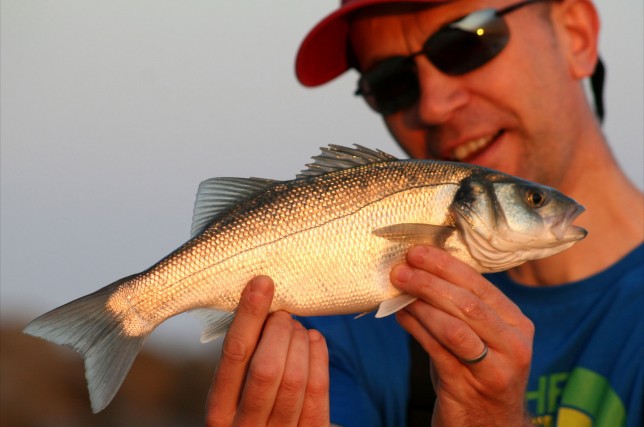The commercial fishing sector is objecting to the setting of the Minimum Conservation Reference Size, (MCRS) for bass at 42cm. They wish to have it set initially at 40cm, at which length many of the bass will not even be mature, let alone have had the opportunity to spawn.
We are, at present, over half way through a year in which scientific evidence recommended cuts of 80% in bass landings the only current restriction is a ban on the sector which accounts for an over exaggerated 25% of those landings.
The pelagic trawl ban was a disaster. It barely reduced landings at all. That is all the more reason to introduce additional emergency measures as soon as possible to get as close as possible to the full 80% reduction in 2015. These measures are required as soon as possible and to protect a stock on the verge of total collapse as a result of commercial over exploitation. This includes targeting fish which have had no opportunity to spawn before being harvested.
Research, (Pawson and Pickett), suggests that the majority of bass are sexually mature at 42cm. That does not mean they are able to spawn. A fish that reaches sexual maturity in April of one year will not have an opportunity to spawn until the following spring. During that time it will have grown around 6cm in length. This indicates that the MCRS needs to be set in the region of 48cm to enable the vast majority of bass to spawn at least once before they are killed. CEFAS research supports this, stating that the best return for the commercial bass fishery will come about with an MLS / MCRS set at 48cm. It is another example where scientific evidence has been ignored to facilitate, short term commercial exploitation. How ironic that an increase in MCRS would actually benefit the commercial sector.
Additionally, spawning ability is related to size. Bigger fish produce bigger eggs and survival of the eggs, larval bass and young fish are more likely with bigger fish. It is common knowledge that with small bass the first year they are capable of spawning is often a “write off”. This is yet another argument to support a MCRS of 48cm.
In recent years, which have seen cold winters, recruitment into the bass fishery has been poor. There are fewer fish of 36cm around than ever before. This indicates that now is the time to increase the MLS / MCRS to a minimum of 42cm.

The commercial sector has argued that a rise in the MCRS will result in the expense of changing gears. How strange that in the same breath they advocate a two stage change which will result in two changes of gears and double the expenditure. Bigger bass are worth more per kilo, so after a year a fishery containing more and bigger bass will offset this small cost.
There is the usual invalid argument from the commercial exploiters about increased discards with an increased MCRS. It has been shown conclusively that the bass fishery is a targeted fishery so discards will not increase UNLESS they are deliberately fished for. Quite frankly the continued use of such an outdated argument smacks of grasping at straws.
The commercial sector claims that an increase in the MCRS will jeopardise their livelihood. This is palpable nonsense. We are not asking them to stop catching bass. We are simply asking that they do not land bass under 42cm. In a year from now these fish will have grown to 42 cm anyway and will be worth significantly more than they would be if caught at 40cm. Moreover, the spawning stock biomass will have increased as a result and will have the potential to bring about the best period of recruitment into the fishery in many years.
Of course there will be a very minor impact upon commercial income for a year. We are trying to bring about a cut of 80% in landings. The commercial sector appears to be under the misapprehension that this can be done without affecting them in any way. Every sector has to shoulder its own share of the 80% cut in landings but the commercials appear to believe that they are exempt from this. By applying the 42cm MCRS across all sectors it is proportionately fair.
While I personally believe that the proposed 42cm MCRS is still far too low I accept that it is the best the bass will get at this moment in time. The recreational sector has already accepted a 3 bag limit. They are supportive of an increased MCRS to 42cm as long as it is across ALL sectors.
The recommended landing figure of 1155t across the restricted area was consciously and calculatedly exceeded by the commercial sector alone at some time in March. The only restriction in place currently is a 3 fish bag limit on a sector purportedly responsible for 25% of the mortality. The industrial sector, responsible for 75% mortality, has no existing restrictions currently limiting their catches. They are free to hunt down a species on the verge of collapse without constraint. It is unsurprising then that with six months of the year passed there appears to be no reduction in bass landings by the commercial sector, let alone the 55% reduction of the total bass catch they need to contribute to.
Please email those listed below – or if you are feeling fired up message as many as you can from this list on the new SOS site: http://www.saveourseabass.org/urgent/ – and demand the full 80% reduction is implemented ASAP and that the commercial fishing sector contributes their fair share.
Ernesto.Bianchi@ec.europa.eu – EU Commission – Management Committee for Fisheries and Aquaculture
lowri.evans@ec.europa.eu – EU Commission
bernhard.friess@ec.europa.eu – EU Commission
karmenu.vella@ec.europa.eu – EU Commission
alain.cadec@europarl.europa.eu – EU Parliament Fisheries Committee Secretariat.dgb2a@consilium.europa.eu – EU – Working Party on Internal and External Fisheries Policy
BASS blogger: David Step